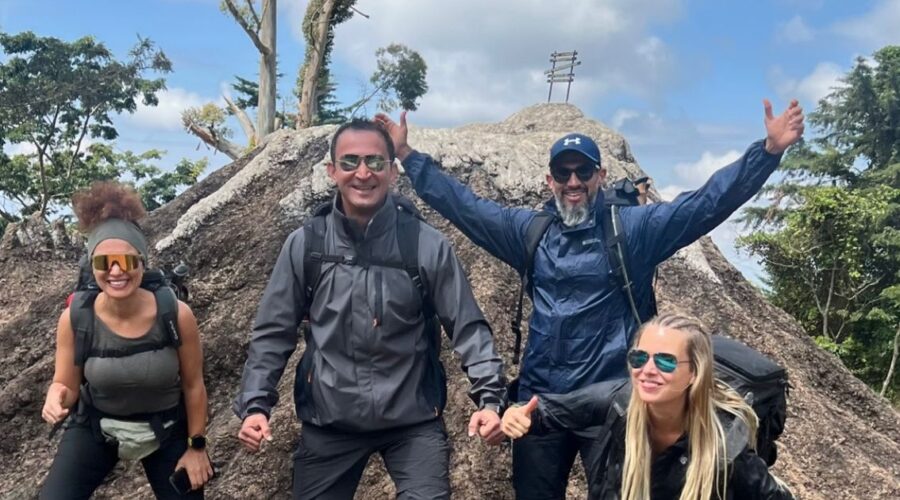Price Includes
Price Excludes
Kilimanjaro stands as Africa’s pinnacle, reaching a soaring height of 5,902 meters (19,365 feet) above sea level. Trekking and climbing to the summit of Mt. Kilimanjaro via various routes offer adventurers an unparalleled experience. Renowned as one of the world’s most remarkable trekking adventures, the journey to Kilimanjaro’s summit promises awe-inspiring vistas and unforgettable memories.
Arrive at the Airport. You will be met at the airport and transferred to our Hotel in Moshi for your overnight dinner and meeting with your tour leader and fellow trekkers
Following breakfast and a briefing, then a scenic drive to the Kilimanjaro National Park Gate, a journey of approximately 2 hours. Upon arrival, we complete the necessary registration procedures before commencing the climb.
The trek begins with a serene walk through the enchanting rainforest, leading to the Mandara encampment. Along the way, consider a side excursion to Maundi Crater for a panoramic view of the surrounding landscapes, offering glimpses of Northern Tanzania and Kenya. Amidst the lush rainforest, keep an eye out for majestic Eucalyptus trees, diverse birdlife, and playful Colobus monkeys.
Details of the day’s trek:
Leaving behind the verdant embrace of the rainforest, you ascend along an open moorland path towards the Horombo encampment. En route, soak in awe-inspiring vistas of Mawenzi and the towering summit of Kibo, casting a spellbinding aura over the landscape. Keep an eye out for the striking giant lobelias and groundsels dotting the terrain.
As you climb higher, you may begin to notice the effects of altitude setting in. Take this transition in stride as you continue your ascent towards the Horombo encampment.
Key details for the day’s trek:
At Horombo Hut, you will spend the day allowing your body to acclimate to high altitude. You will have the option of doing a day hike to Mawenzi Hut (4600m) for further acclimatization with your guide. Breakfast and dinner will be at the hut and lunch will either be packed or at the hut depending on your preference for the day.
hroughout the day, enjoy hearty breakfast and dinner meals at the hut, while lunch can either be packed for your hike or served at the hut, tailored to your preference for the day. Take advantage of this time to rest, hydrate, and fully embrace the mountain environment, ensuring you’re ready for the next leg of your Kilimanjaro adventure.
Continuing our ascent, we traverse past the final watering point, progressing onto the saddle of Kilimanjaro nestled between the majestic peaks of Kibo and Mawenzi. As we ascend, the landscape transitions from upper heathland to a barren “moonscape,” devoid of vegetation but brimming with otherworldly beauty.
Upon reaching our destination, we settle in for dinner, allowing our bodies to rest and recharge in preparation for the forthcoming summit climb.
Key details for this segment of the trek:
In the early hours of the morning, typically between midnight and 2:00 AM, we embark on the challenging ascent to the summit of Kilimanjaro. The path ahead is steep and rugged, comprising heavy scree or snow, leading us towards Gilman’s Point, situated on the crater rim. Despite the arduous terrain, the anticipation of reaching such a monumental milestone fuels our determination.
Continuing our ascent, we press onward towards Uhuru Peak, the highest point in Africa. With every step, we’re rewarded with breathtaking vistas, each turn revealing awe-inspiring panoramas that defy description. Upon reaching the summit, be sure to capture the moment with a commemorative photo—a testament to your indomitable spirit and unwavering resolve.
Following this triumphant achievement, we begin our descent, pausing for a well-deserved rest and nourishing lunch at Kibo before continuing our journey to the Horombo encampment. The initial part of the descent is shrouded in darkness, requiring the use of headlamps or flashlights to navigate safely through the terrain.
As we descend, the temperature gradually warms, but until then, it’s crucial to layer up with all available warm clothing to combat the biting cold. This descent is undoubtedly the most demanding part of the trek, characterized by numerous switchbacks and challenging terrain. However, by adopting a steady and deliberate pace—often referred to as “pole pole”—and maintaining a positive mindset, we’ll conquer every obstacle in our path.
Key details for this leg of the journey:
Following a hearty breakfast, we commence our descent, embarking on a steady journey through the moorland terrain towards the Mandara Hut. As we descend, the landscape gradually transforms, offering glimpses of the lush forest canopy below.
Continuing our descent, we navigate through the verdant forest path, making our way towards the National Park gate at Marangu. At lower elevations, the terrain may be damp and muddy, so we recommend wearing gaiters and utilizing trekking poles for added stability. While shorts and t-shirts may suffice for most of the journey, it’s advisable to keep rain gear and warmer clothing readily accessible.
Upon reaching the Marangu gate, our awaiting vehicle will transport you back to the hotel or the airport, marking the conclusion of our unforgettable Kilimanjaro adventure. As we bid farewell to this extraordinary journey, don’t forget to express your gratitude to our guides and porters through a well-deserved tip. It’s time to celebrate your incredible achievement and the memories created along the way!
Key details for the descent:
Reflect on the journey, cherish the experiences, and revel in the sense of accomplishment as we bid farewell to Kilimanjaro’s majestic slopes.
it’s time to bid farewell to the awe-inspiring landscapes of Kilimanjaro and embark on your journey homeward. After a restful night’s sleep and a final breakfast, we prepare for departure.
While Kilimanjaro trekking does not require technical climbing skills, a good level of fitness is essential. Regular aerobic exercise and strength training are recommended to prepare for the physical demands of the trek.
It’s advisable to book your Kilimanjaro trek at least 6-12 months in advance, especially during peak trekking seasons, to secure permits, accommodations, and preferred dates.
Focus on cardiovascular exercises such as hiking, running, and cycling to improve endurance. Additionally, strength training exercises targeting the legs, core, and upper body can help build muscular strength required for trekking.
You’ll need a Kilimanjaro trekking permit, arranged by your tour operator, and a valid passport with a tourist visa for Tanzania, which can be obtained upon arrival or in advance.
Essential gear includes sturdy hiking boots, warm clothing layers, a sleeping bag, trekking poles, a headlamp, sunscreen, and a refillable water bottle. Your tour operator will provide a detailed packing list.
Popular routes include the Marangu, Machame, Lemosho, Rongai, and Northern Circuit routes, each offering unique landscapes and varying degrees of difficulty.
Consider factors such as trekking experience, fitness level, preferred duration, and scenic preferences when selecting a route. Consulting with experienced trekking guides can also help you make an informed decision.
The best time to trek Kilimanjaro is during the dry seasons of January to March and June to October, which offer clearer skies and more stable weather conditions.
Common risks include altitude sickness, dehydration, hypothermia, and physical injuries. Adequate preparation, acclimatization, and adherence to safety guidelines can minimize these risks.
Gradual ascent, proper hydration, adequate rest, and altitude medication (if recommended by a healthcare professional) are key strategies for preventing altitude sickness. Listen to your body and communicate any symptoms to your guide.
Basic medical facilities are available at certain campsites and ranger stations along the Kilimanjaro trekking routes. However, it’s essential to carry a personal first aid kit and any necessary medications.
Recommended vaccinations include yellow fever, hepatitis A and B, typhoid, and tetanus. Consult with a travel medicine specialist or your healthcare provider for personalized advice based on your medical history and travel itinerary.
Tour operators typically have emergency evacuation plans in place, utilizing helicopters or stretcher carries in the event of serious accidents or illnesses. Guides are trained in first aid and can provide initial medical assistance.
Accommodation options vary depending on the route and tour package, ranging from mountain huts to tents. Mountain huts on popular routes like Marangu offer basic amenities such as bunk beds and communal dining areas.
Basic toilet facilities are available at designated campsites and rest stops, consisting of pit latrines or eco-toilets. It’s essential to practice Leave No Trace principles and follow proper waste disposal guidelines.
Most tour operators provide full-board meal plans, including breakfast, lunch, and dinner, prepared by experienced cooks. Meals typically consist of a variety of nutritious dishes to fuel trekkers throughout the journey.
You can book a Kilimanjaro trekking tour through specializing in adventure travel. Research different operators, read reviews, and compare itineraries and prices before making a reservation.
You can book by small deposit
Inclusions typically cover services such as park fees, permits, guide and porter services, accommodation, meals, and airport transfers. Review the itinerary and terms carefully to understand what is included.
cash only
Please refer to our cancelation policy here
Additional expenses may include personal gear and equipment, travel insurance, visa fees, gratuities for guides and porters, optional excursions, and souvenirs. Budget accordingly and clarify any potential extra costs with your tour operator.

